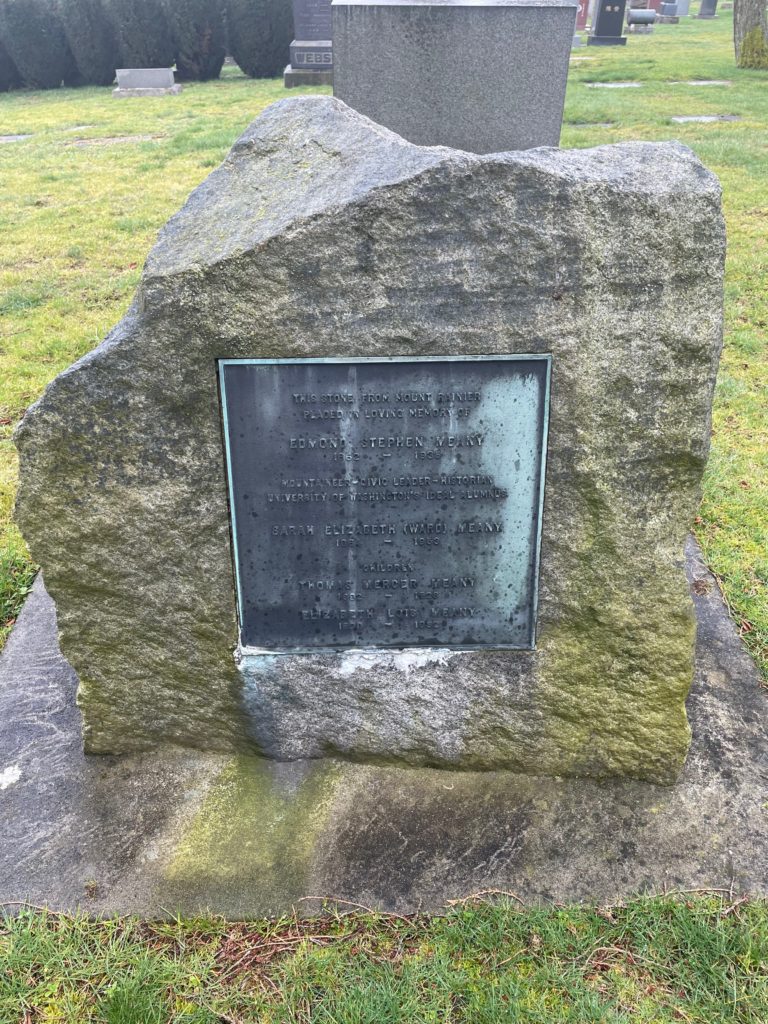Erik Visits an American Grave, Part 1,124
This is the grave of Edmond Meany.

Born in 1862 in East Saginaw, Michigan, Meany moved out to Washington Territory at some point during his early life, I think in the mid 1870s. His father worked on a boat on the Skagit River. In 1880, dad fell off said boat and drowned. Meany was the oldest child and it was now up to him to support the family. He graduated from the University of Washington in 1885. He stayed there for a master’s degree in science in 1899 and then got another master’s degree from the University of Wisconsin in 1901. His academic specialty was botany, but his real interest was history. He would get a faculty job at the University of Washington, where he taught both subjects. He had also worked under Frederick Jackson Turner at Wisconsin and most definitely imbibed Turner’s frontier thesis, which would shape Meany’s view of the Northwest.
Meany served a couple of terms in the state legislature in the early 1890s. While there, he pushed hard for a new campus for the University of Washington. If you have been to Washington’s campus today, you know it has a strong argument for among the most beautiful in the nation, especially because of that view of Mt. Rainier when the mountain is out, as we see in the Northwest. To get the state legislature to pony up the money for that campus and the layout that it began to have, he worked closely with the timber industry, who found the idea of a school that combined both agriculture and traditional studies interesting. While Washington State University is the land-grant school in that state, it is Washington that has the forestry program and it was one of the top in the nation during the years when the point of forestry was to cut down as many trees as possible.
Meany then was one of the main guys pushing for the Alaska-Yukon-Pacific Exposition to be held at the university in 1909. This was a World’s Fair intended to promote Seattle and the west coast to the world. The nation was in its peak of these events, with Chicago in 1893 and St. Louis in 1904 important examples. So naturally Seattle wanted its own. Meany pushed his colleagues to have it on the university campus and promote that too. They hired the Olmsted Brothers to design the thing. This was not as big as the Chicago and St. Louis examples. In the end, only a few other countries bothered showing up with their own exhibits. But it was still an important moment in the development of the Pacific Northwest.
Meany became an early historian of what was still a very new state.In 1906, Meany took over the editorship of the Washington Historical Quarterly, the state’s leading historical journal. Today that is the Pacific Northwest Quarterly. I’ve published in that journal myself. In 1909, he wrote a history of the University of Washington and then a history of the state of Washington. In 1915, he wrote Governors of Washington: Territories and State. That era saw a lot of chronicles like this. Most of our state historical societies were founded shortly after statehood by local elites who thought of themselves as great men and wanted to control the narrative of how the story was told. Meany was very much of this ilk. As a Turnerian who pretty much believed that Native peoples were going extinct, he, like so many academic whites of the early twentieth century, sought to visit the reservations and chronicle life and stories and artifacts there. So Meany became pretty well known among the many small tribes of western Washington as he did his thing down there. He also wrote Mount Rainier: A Record of Exploration in 1916, as this was perhaps a more important and beautiful landmark than any other state has. I mean you can see the thing in pretty close to the majority of the state. Meany himself was an active mountaineer himself and was president of a local climbing and skiing club.
In 1903, Meany brought Chief Joseph, the legendary war chief of the Nez Perce, to the University of Washington. A quarter-century after the awful genocidal campaign against his people, Joseph was still fighting for them, trying to get them back to their lands in Oregon and Idaho. One of the reasons to get him to Seattle was that the photographer Edward Curtis, who specialized in work of the “dying Indian” wanted to document a man who whites had already started romanticizing while not actually allowing him to return home. Curtis told Meany he considered Joseph to be “one of the greatest men who ever lived” but neither the photographer or the historian really wanted to do anything to help Joseph return home. In fact, Joseph died the next year on the Colville Reservation up in northeastern Washington, which was as close as his people would get to returning home. But to be fair I guess, Meany did call the Nez Perce prisoners of war in his writing in 1901, which did get the issue some attention. Meany and Curtis became good friends and the historian got go to on Curtis’ 1907 expedition to the Great Plains to photograph the aging generation of those who resisted white encroachment. Meany enjoyed this very much.
Meany continued teaching at Washington until 1932. He died in Seattle in 1935, at the age of 72, after having a stroke in his office at the university.
Edmond Meany is buried in Lake View Cemetery, Seattle, Washington.
If you would like this series to visit other students of Frederick Jackson Turner, you can donate to cover the required expenses here. Carl Becker is in Ithaca, New York and Herbert Eugene Bolton is in El Cerrito, California. Previous posts in this series are archived here.


